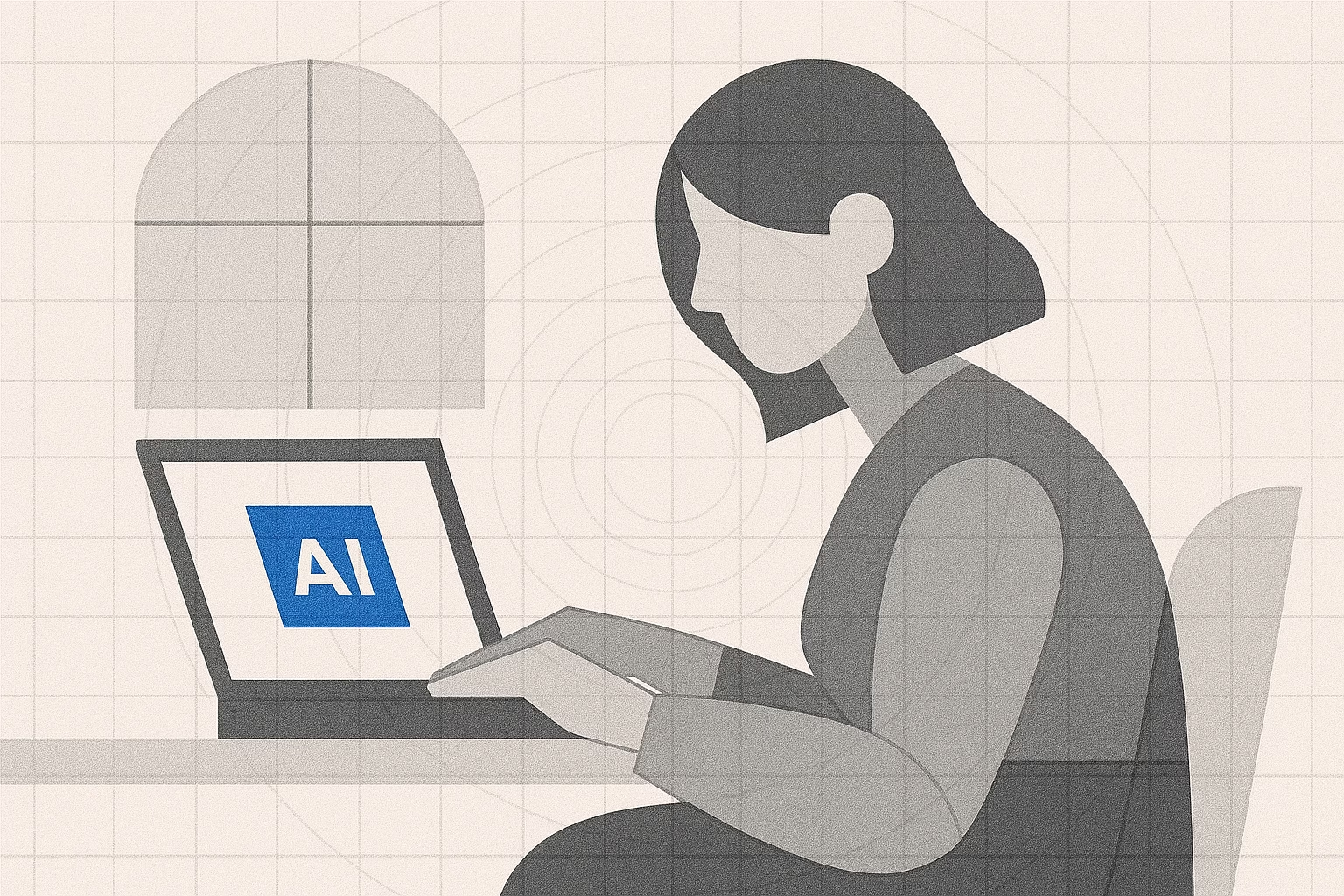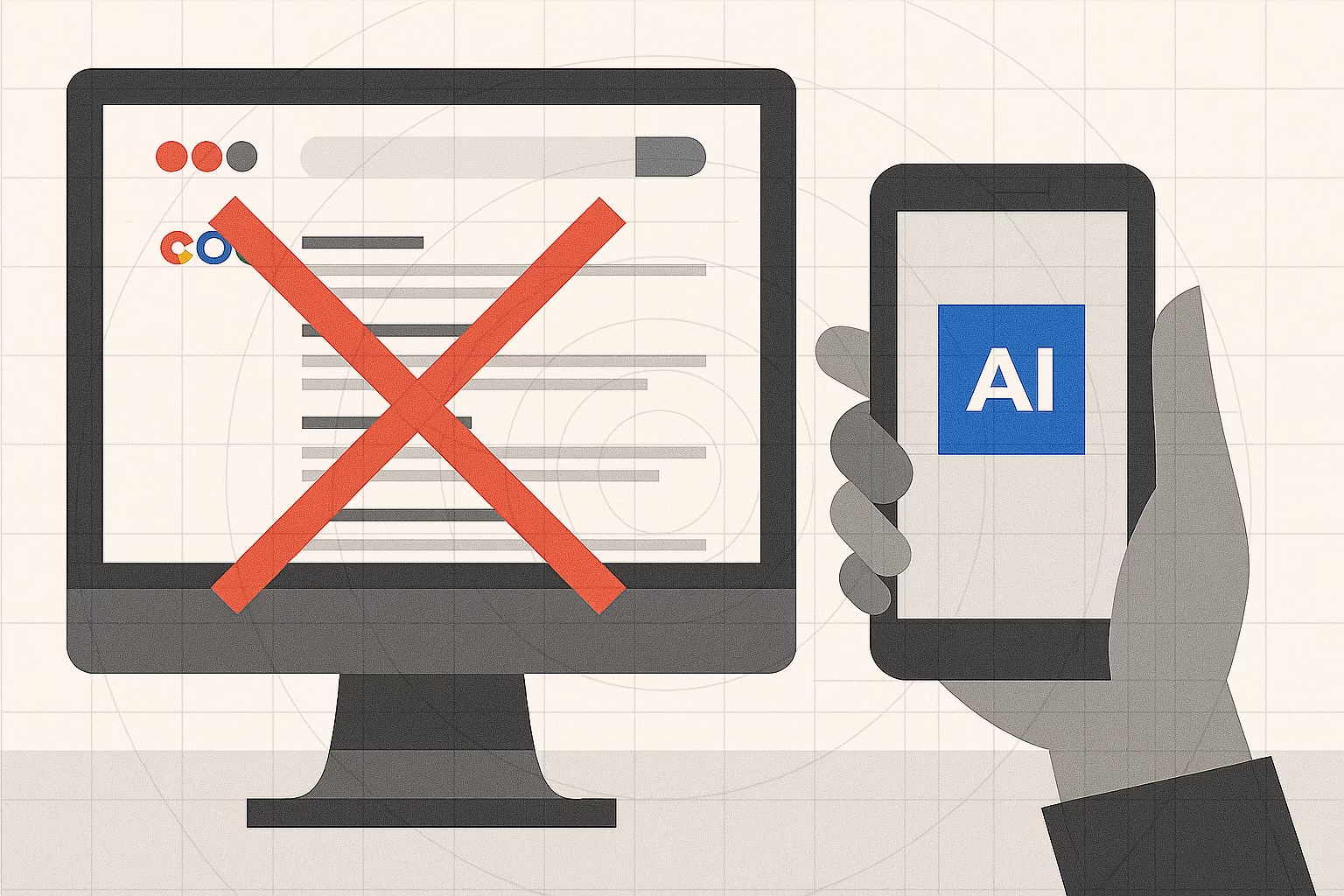Inside
- Discover why Google’s market share is quietly declining and what it means for product discovery
- Learn how conversational AI is replacing traditional keyword-based searching—and why your optimisation strategy needs to evolve
- Explore the shift from “being visited” to “being cited” by AI systems and how to design for zero-click experiences
- Understand the new rules of AI search optimisation and how to make your product discoverable when users never visit your site
- Rethink everything you thought you knew about search metrics and user journey design in an AI-first world
It struck me recently that I haven’t typed a query into Google Search for half a year. For someone who once relied on it dozens of times a day, that’s a quiet but profound shift. I didn’t make a conscious decision to stop—it just happened, like gradually abandoning your landline for your mobile phone—not through conscious choice, but because one option simply became more natural than the other.
This personal revelation made me wonder if I was an outlier, or part of something larger. The data suggests the latter. Google’s global search market share dipped below 90% in 2025 for the first time in nearly a decade, settling around 89.7%. On desktop, the decline is sharper—roughly 79%—still dominant, but no longer the unquestioned monopoly it once was. For those of us who build digital products, these aren’t just statistics. They’re early signals of a tectonic shift in how people discover, learn, and make decisions online.
But here’s what’s really telling: I didn’t replace Google with another search engine. I replaced it with conversation.
The Language of Discovery
Instead of thinking “best running shoes reviews 2025” and typing those exact words into a search box, I found myself asking an AI assistant, “What’s a good running shoe for someone who runs three times a week on mixed terrain?” The difference isn’t just semantic—it’s cognitive. I stopped translating my actual questions into keyword-speak and started asking what I really wanted to know.
This shift represents something far more significant than a new interface. When we optimised our content for “best running shoes reviews,” we were designing for Google’s understanding of language circa 2010. We broke our natural thoughts into digestible keywords because that’s what the algorithm demanded. But what happens when the algorithm starts to think more like we do?
The answer is already emerging. Nearly 60% of Google searches in 2024 ended in “zero clicks”—users got what they needed directly from the results page. With Google’s AI Overviews now summarising answers at the top of search results, appearing in over 13% of U.S. queries by March 2025, that trend is accelerating. Search is transforming from a directory of links into something closer to a knowledgeable friend who synthesises answers from everything they’ve ever read.
For product teams, this creates a fascinating paradox. We spent decades learning to speak the language of search engines, only to discover that the future belongs to systems that speak our language instead.
The Invisible Web
What’s emerging isn’t just a new kind of search—it’s the gradual dissolution of search as a discrete activity. I realise now that my queries haven’t disappeared; they’ve dispersed. When I ask my phone for directions while driving, that’s a search. When I describe a problem to an AI assistant embedded in my design software, that’s a search too. When I scan a barcode with my camera to compare prices, or ask a chatbot about a product’s specifications, I’m searching without ever thinking of it as “searching.”
This invisibility is profound. Search used to be a place you went—you opened Google, typed a query, scrolled through results. Now it’s a layer that exists everywhere, embedded in every app, every device, every interaction. A Prosper Insights survey found that up to one-third of U.S. adults already use AI tools to assist with everyday decisions, often without recognising these interactions as searches at all.
For those of us building products, this shift demands a fundamental reconsideration of where and how our work gets discovered. The old model was elegantly simple: rank well on Google, get traffic, convert visitors. But what happens when there are no visitors to convert because the AI has already answered their question? AI search optimisation.

The Death and Rebirth of Traffic
Traditional web metrics feel increasingly hollow in this new landscape. Click-through rates, bounce rates, time on page—all assume that discovery means arrival. But if an AI system can surface your product’s key benefits, pricing, and reviews without anyone ever clicking through to your site, what does “success” look like?
I’ve started thinking about this as the difference between being visited and being cited. In the old model, you wanted people to come to your site. In the emerging model, you want to be the source that AI systems trust and reference. Adobe reported a 1,200% spike in AI-driven referral traffic in 2025, suggesting that bots are increasingly intermediating the discovery process. But this isn’t just about getting crawled—it’s about being worthy of citation.
This shift forces uncomfortable questions about the infrastructure we’ve built. If your content strategy is optimised for human visitors who spend three minutes reading your product page, how do you redesign it for AI systems that consume and synthesise that information in milliseconds? If your brand differentiation relies on visual design and interactive elements that only exist on your website, how do you maintain that distinctiveness when your product is reduced to a few lines in an AI summary?
Designing for the In-Between
The most challenging aspect of this transformation isn’t technical—it’s conceptual. We’re building products for a world where the primary interaction might not be direct. Your customer’s first meaningful encounter with your brand might happen through an AI assistant that has never “visited” your website but has somehow absorbed everything your website contains.
This creates what I think of as the “citation challenge.” In academic writing, being cited is more valuable than being read—it means your work has contributed to a larger understanding. Product discovery is moving toward a similar model. The question isn’t just whether people can find your product, but whether AI systems consider your product worth recommending.
Consider the implications for design. If a user never lands on your carefully crafted homepage, your value proposition needs to be embedded in the very structure of your content—clear enough for an AI to parse, compelling enough for it to recommend, distinctive enough to differentiate you from competitors who might offer similar functionality.
The traditional advice was to “design for users, not algorithms.” But what do you do when the algorithm is increasingly indistinguishable from the user’s experience of discovery?
The New Optimisation
SEO isn’t dead, but it’s undergoing a profound evolution. The old playbook—keywords, backlinks, technical optimisation—remains relevant, but it’s no longer sufficient. Botify’s 2025 survey found that 94% of marketing leaders felt at least somewhat prepared to optimise for AI search, with 62% already adjusting their strategies. But “optimising for AI” isn’t like optimising for Google circa 2015. It’s less about gaming an algorithm and more about becoming genuinely useful.
The emerging best practices feel almost revolutionary in their simplicity: write clearly, structure information logically, cite your sources, update regularly, and be transparent about limitations. In other words, create content that would be valuable to an incredibly smart, well-informed colleague—because that’s essentially what these AI systems are becoming.
This shift toward AI search optimisation clarity and structure over clever optimisation feels like a return to fundamentals. But it also demands new skills. Product teams need to think like librarians, ensuring their information is catalogued, cross-referenced, and contextualised. They need to think like journalists, providing clear attribution and transparent sourcing. They need to think like teachers, structuring information so it builds understanding rather than just delivering facts.
Trust in the Age of Synthesis
Perhaps the most profound challenge is trust. When information flows through AI intermediaries, traditional signals of credibility—brand recognition, visual design, user reviews displayed on your site—become filtered through algorithmic interpretation. Users increasingly interact with synthesised versions of your content rather than experiencing it directly.
This creates both opportunity and responsibility. On one hand, if AI systems trust your information enough to cite it, you can reach users who might never have discovered you through traditional search. On the other hand, you’re now responsible not just for your own presentation of information, but for how that information might be interpreted and represented by systems you don’t control.
The brands that succeed in this environment will likely be those that view AI systems not as obstacles to direct customer relationships, but as potential partners in customer education. Instead of trying to capture every interaction, they’ll focus on being consistently useful across whatever channels their customers prefer to use.
Living in the Question
Six months without Google has taught me something unexpected. I don’t miss it. I don’t feel less informed, less connected, or less capable. If anything, I feel more aligned with how I naturally think and ask questions. The tools I now use feel closer to conversation than interrogation, closer to dialogue than database queries.
But this isn’t a story about me abandoning one search engine for another. It’s about the quiet revolution happening in how we all discover information. Search is no longer a destination. It’s becoming an invisible layer, woven into every interaction, every app, every device. For product managers, UX designers, and product designers, the challenge is not just to adapt to this new landscape but to shape it—ensuring that discovery remains meaningful, trustworthy, and human, even when mediated by machines.
The future of search may not look like search at all. It may look like conversation, like guidance, like context that appears exactly when you need it. And for those of us building the products of tomorrow, the real work is to design for that future—not by clinging to the metrics of the past, but by embracing the questions that will define what comes next.
tl;dr
- Search is becoming conversational: Users are abandoning keyword-thinking for natural language queries with AI assistants
- Zero-click dominance: 60% of searches end without clicks; success means being cited by AI, not visited by humans
- Discovery is everywhere: Search has dissolved into every app and interaction—it’s no longer a destination but an invisible layer
- New optimisation rules: Clear writing, structured data, and machine-readable content matter more than traditional SEO tactics
- Trust becomes currency: In an AI-mediated world, being a reliable source for AI systems is the new competitive advantage
- Design for synthesis: Your content needs to work when consumed second-hand through AI summaries and recommendations


